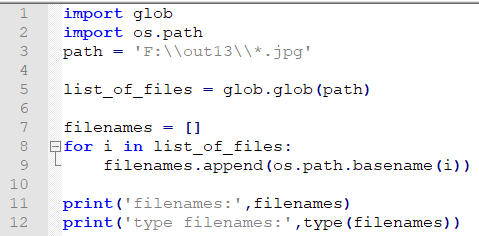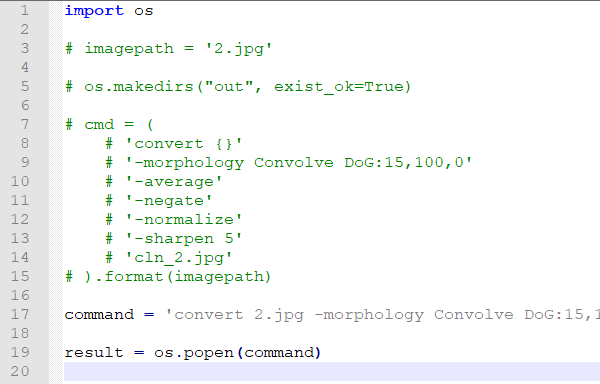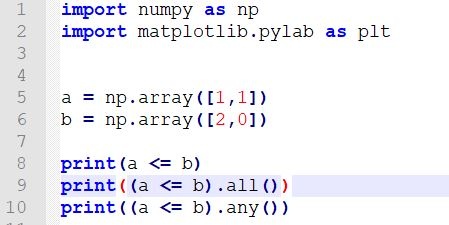目前分類:python (15)
- Feb 18 Tue 2020 16:24
python執行cmd指令
- Feb 18 Tue 2020 10:37
Python FileNotFoundError: [WinError 2] 系统找不到指定的文件
- Feb 16 Sun 2020 18:53
取路徑下所有檔案檔名

- Feb 11 Tue 2020 14:10
關於python import path
- Dec 25 Wed 2019 10:53
fuzzysearch in python
from fuzzysearch import find_near_matches
- Nov 26 Tue 2019 20:48
numpy array 比對大小與等於
- Jun 10 Mon 2019 14:45
virtualenv
- Jun 08 Sat 2019 15:09
virtualenv && flask架網站
- Nov 30 Fri 2018 16:46
Logs
# Youtube video tutorial: https://www.youtube.com/channel/UCdyjiB5H8Pu7aDTNVXTTpcg # Youku video tutorial: http://i.youku.com/pythontutorial
- Nov 30 Fri 2018 16:44
TensorBoard(二)
import tensorflow as tf import numpy as np # 定義一個添加層的函數 def add_layer(inputs, input_tensors, output_tensors, activation_function=None): with tf.name_scope('Layer'): with tf.name_scope('Weights'): W = tf.Variable(tf.random_normal([input_tensors, output_tensors])) with tf.name_scope('Biases'): b = tf.Variable(tf.zeros([1, output_tensors])) with tf.name_scope('Formula'): formula = tf.add(tf.matmul(inputs, W), b) if activation_function is None: outputs = formula else: outputs = activation_function(formula) return outputs # 準備資料 x_data = np.random.rand(100) x_data = x_data.reshape(len(x_data), 1) y_data = x_data * 0.1 + 0.3 # 建立 Feeds with tf.name_scope('Inputs'): x_feeds = tf.placeholder(tf.float32, shape=[None, 1]) y_feeds = tf.placeholder(tf.float32, shape=[None, 1]) # 添加 1 個隱藏層 hidden_layer = add_layer(x_feeds, input_tensors=1, output_tensors=10, activation_function=None) # 添加 1 個輸出層 output_layer = add_layer(hidden_layer, input_tensors=10, output_tensors=1, activation_function=None) # 定義 `loss` 與要使用的 Optimizer with tf.name_scope('Loss'): loss = tf.reduce_mean(tf.square(y_feeds - output_layer)) with tf.name_scope('Train'): optimizer = tf.train.GradientDescentOptimizer(learning_rate=0.01) train = optimizer.minimize(loss) # 初始化 Graph init = tf.global_variables_initializer() sess = tf.Session() # 將視覺化輸出 writer = tf.summary.FileWriter("TensorBoard/", sess.graph) # 開始運算 sess.run(init) for step in range(201): sess.run(train, feed_dict={x_feeds: x_data, y_feeds: y_data}) # if step % 20 == 0: # print(sess.run(loss, feed_dict = {x_feeds: x_data, y_feeds: y_data})) sess.close() # 打開cmd,cd到tensorflow資料夾前一目錄 # $tensorboard --logdir=TensorBoard
import tensorflow as tf
import numpy as np
# 定義一個添加層的函數
def add_layer(inputs, input_tensors, output_tensors, activation_function=None):
with tf.name_scope('Layer'):
with tf.name_scope('Weights'):
W = tf.Variable(tf.random_normal([input_tensors, output_tensors]))
with tf.name_scope('Biases'):
b = tf.Variable(tf.zeros([1, output_tensors]))
with tf.name_scope('Formula'):
formula = tf.add(tf.matmul(inputs, W), b)
if activation_function is None:
outputs = formula
else:
outputs = activation_function(formula)
return outputs
# 準備資料
x_data = np.random.rand(100)
x_data = x_data.reshape(len(x_data), 1)
y_data = x_data * 0.1 + 0.3
# 建立 Feeds
with tf.name_scope('Inputs'):
x_feeds = tf.placeholder(tf.float32, shape=[None, 1])
y_feeds = tf.placeholder(tf.float32, shape=[None, 1])
# 添加 1 個隱藏層
hidden_layer = add_layer(x_feeds, input_tensors=1, output_tensors=10, activation_function=None)
# 添加 1 個輸出層
output_layer = add_layer(hidden_layer, input_tensors=10, output_tensors=1, activation_function=None)
# 定義 `loss` 與要使用的 Optimizer
with tf.name_scope('Loss'):
loss = tf.reduce_mean(tf.square(y_feeds - output_layer))
with tf.name_scope('Train'):
optimizer = tf.train.GradientDescentOptimizer(learning_rate=0.01)
train = optimizer.minimize(loss)
# 初始化 Graph
init = tf.global_variables_initializer()
sess = tf.Session()
# 將視覺化輸出
writer = tf.summary.FileWriter("TensorBoard/", sess.graph)
# 開始運算
sess.run(init)
for step in range(201):
sess.run(train, feed_dict={x_feeds: x_data, y_feeds: y_data})
# if step % 20 == 0:
# print(sess.run(loss, feed_dict = {x_feeds: x_data, y_feeds: y_data}))
sess.close()
# 打開cmd,cd到tensorflow資料夾前一目錄
# $tensorboard --logdir=TensorBoard
- Nov 30 Fri 2018 16:42
tensorboard (一)
''' 為了克服python基本運算緩慢的問題 (因為 tensorflow 使用 GPU、多工 例:A+B用TF算比C慢) tensorflow 採用預先建構完整的運算式 再一起進行運算的方式 ''' import tensorflow as tf # none 為任意數目,784 為每個樣本所含總pixel,placeholder 為預先空出喂資料的空間 x = tf.placeholder(tf.float32, [None, 784]) # input (mnist images) # variable 在計算過程中可更改 W = tf.Variable(tf.zeros[784, 10]) # weight ,10表示樣本各pixel在類別1~10的分別機率 b = tf.Variable(tf.zeros[10]) # bias # softmax 在最後輸出前,整理神經網路結果(wx+b),使結果都介於 0~1 且相加為1 y = tf.nn.softmax(tf.matmul(x, W)+b) # 訓練 # Loss(/Cost) 為目前訓練模型與實際模型的差,用來判斷模型好壞 # 使用 cross-entropy 來決定 loss function y_ = tf.placeholder(tf.float32, [None, 10]) # 實際答案 cross_entropy = tf.reduce_mean()
'''
為了克服python基本運算緩慢的問題
(因為 tensorflow 使用 GPU、多工 例:A+B用TF算比C慢)
tensorflow 採用預先建構完整的運算式
再一起進行運算的方式
'''
import tensorflow as tf
# none 為任意數目,784 為每個樣本所含總pixel,placeholder 為預先空出喂資料的空間
x = tf.placeholder(tf.float32, [None, 784]) # input (mnist images)
# variable 在計算過程中可更改
W = tf.Variable(tf.zeros[784, 10]) # weight ,10表示樣本各pixel在類別1~10的分別機率
b = tf.Variable(tf.zeros[10]) # bias
# softmax 在最後輸出前,整理神經網路結果(wx+b),使結果都介於 0~1 且相加為1
y = tf.nn.softmax(tf.matmul(x, W)+b)
# 訓練
# Loss(/Cost) 為目前訓練模型與實際模型的差,用來判斷模型好壞
# 使用 cross-entropy 來決定 loss function
y_ = tf.placeholder(tf.float32, [None, 10]) # 實際答案
cross_entropy = tf.reduce_mean()
- Nov 30 Fri 2018 16:37
利用筆電鏡頭擷取frame
import cv2 # 使用視訊鏡頭擷取影像 cv2.namedWindow("preview") vc = cv2.VideoCapture(0) if vc.isOpened(): # try to get the first frame rval, frame = vc.read() else: rval = False count = 0 while rval: cv2.imshow("preview", frame) # 產生視窗 rval, frame = vc.read() cv2.imwrite("frame%d.jpg" % count, frame) # 將影格轉為 frame key = cv2.waitKey(100) # 調整影格數 if key == 27: # 按esc停止 break count += 1 cv2.destroyWindow("preview")
import cv2
# 使用視訊鏡頭擷取影像
cv2.namedWindow("preview")
vc = cv2.VideoCapture(0)
if vc.isOpened(): # try to get the first frame
rval, frame = vc.read()
else:
rval = False
count = 0
while rval:
cv2.imshow("preview", frame) # 產生視窗
rval, frame = vc.read()
cv2.imwrite("frame%d.jpg" % count, frame) # 將影格轉為 frame
key = cv2.waitKey(100) # 調整影格數
if key == 27: # 按esc停止
break
count += 1
cv2.destroyWindow("preview")
- Nov 30 Fri 2018 16:15
MINIST練習
import tensorflow as tf
from tensorflow.examples.tutorials.mnist import input_data
INPUT_NODE = 784
OUTPUT_NODE = 10
LAYER1_NODE = 500
BATCH_SIZE = 100
LEARNING_RATE_BASE = 0.8
LEARNING_RATE_DECAY = 0.99
REGULARIZATION_RATE = 0.0001
TRAINING_STEPS = 30000
MOVING_AVERAGE_DECAY = 0.99
def inference(input_tensor, avg_class, weights1,
biases1, weights2, biases2):
if avg_class is None:
layer1 = tf.nn.relu(tf.matmul(input_tensor, weights1) + biases1)
return tf.matmul(layer1, weights2) + biases2
else:
layer1 = tf.nn.relu(
tf.matmul(input_tensor, avg_class.average(weights1) + avg_class.average(biases1)))
return tf.matmul(layer1, avg_class.average(weights2) + avg_class.average(biases2))
# 訓練模型的過程
def train(mnist):
x = tf.placeholder(tf.float32, [None, INPUT_NODE], name='x-input')
y_ = tf.placeholder(tf.float32, [INPUT_NODE, OUTPUT_NODE], name='y-input')
# 生成隱藏層參數
weights1 = tf.Variable(
tf.truncated_normal([INPUT_NODE, LAYER1_NODE], stddev=0.1))
biases1 = tf.Variable(tf.constant(0.1, shape=[LAYER1_NODE]))
# 生成輸出層參數
weights2 = tf.Variable(
tf.truncated_normal([LAYER1_NODE, OUTPUT_NODE], stddev=0.1))
biases2 = tf.Variable(tf.constant(0.1, shape=[OUTPUT_NODE]))
y = inference(x, None, weights1, biases1, weights2, biases2)
global_step = tf.Variable(0, trainable=False)
variable_averages = tf.train.ExponentialMovingAverage(
MOVING_AVERAGE_DECAY, global_step)
variables_averages_op = variable_averages.apply(
tf.trainable_variables())
average_y = inference(
x, variable_averages, weights1, biases1, weights2, biases2)
cross_entropy = tf.nn.sparse_softmax_cross_entropy_with_logits(y, tf.argmax(y_, 1))
cross_entropy_mean = tf.reduce_mean(cross_entropy)
regularizer = tf.contrib.layers.l2_trgularizer(REGULARIZATION_RATE)
regularization = regularizer(weights1) + regularizer(weights2)
loss = cross_entropy_mean + regularization
learning_rate = tf.train.exponential_delay(
LEARNING_RATE_BASE, global_step, mnist.train.num_examples / BATCH_SIZE,
LEARNING_RATE_DECAY)
train_step = tf.train.GradientDescentOptimizer(learning_rate).minimize(loss, global_step=global_step)
with tf.control_dependencies([train_step, variables_averages_op]):
train_op = tf.no_op(name='train')
correct_prediction = tf.equal(tf.argmax(average_y, 1), tf.argmax(y_, 1))
accuracy = tf.reduce_mean(tf.cast(correct_prediction, tf.float32)) # 模型在這組數劇上的正確性
with tf.Session() as sess:
tf.global_variables_initializer().run()
validate_feed = {x: mnist.validation.images,
y_: mnist.validation. labels}
test_feed = {x: mnist.test.images, y_: mnist.test.labels}
for i in range(TRAINING_STEPS):
if i % 1000 == 0:
validate_acc = sess.run(accuracy, feed_dict=validate_feed)
print("After %d training step(s), validation accuracy"
"using average model is %g " % (i, validate_acc))
xs, ys = mnist.train.next_batch(BATCH_SIZE)
sess.run(train_op, feed_dict={x: xs, y_: ys}) # 運行訓練過程
test_acc = sess.run(accuracy, feed_dict=test_feed)
print("After %d training step(s), test accuracy using average "
"model is %g " % (TRAINING_STEPS, test_acc))
# 主程序入口
def main(argv=None):
mnist = input_data.read_data_sets("/tmp/data", one_hot=True)
train(mnist)
if __name__ == '__main__':
tf.app.run()
- Nov 30 Fri 2018 15:47
python用matplotlib畫二維圖& 貼code在blog的方法
import matplotlib.pyplot as plt
import numpy as np
# 畫一個 0~180 度的 sin 波
x = np.arange(0, 180)
y = np.sin(x*np.pi/180.0)
plt.plot(x, y)
# 設定圖的範圍
plt.xlim(-30, 390)
plt.ylim(-1.5, 1.5)
plt.xlabel("x-axis")
plt.ylabel("y-axis")
plt.title("The title")
plt.show()
- Apr 22 Sun 2018 13:44
搞懂for loop中的global variable - python








